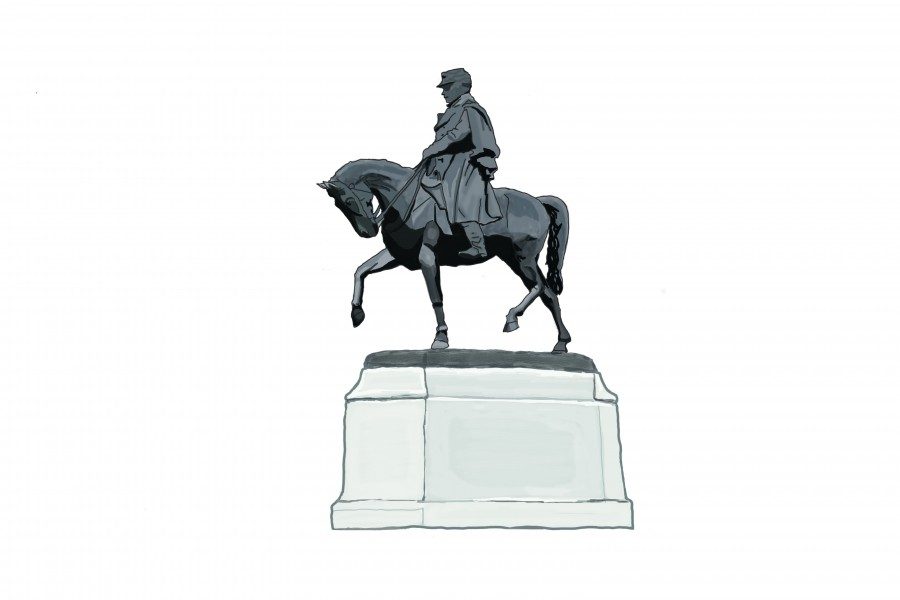Ask Views: Confederate monuments and what to do with them
The following columns are opinions and do not represent the views of The Tulane Hullabaloo.

Taking down the Confederate monuments is a good first step in acknowledging the discriminatory history they represent, but we cannot forget this history. Placing these monuments on display in a museum is a way for people to look at them and learn about the problematic history they represent without necessarily having them in a space where they are idolized. By having them in a forum where people can learn about these figures, it is possible that we can avoid repeating the horrific acts they committed. As for what we should do with the former monument sites, the city should leave them empty. Having them remain blank is a symbolic gesture that demonstrates the major step New Orleans took in taking down the monuments, one that we cannot and should not forget.
Daniel is a senior at Newcomb-Tulane College. He can be reached at dhorowi@tulane.edu.

Confederate monuments are monuments to terror. These monuments were never built to respect soldiers who died or preserve Southern culture. These monuments were mostly constructed in the South between the years of 1890 and 1950 for a very specific purpose: to scare marginalized communities and remind them of Jim Crow. These monuments are not celebrating a cause but rather are a directed message, mass-produced and distributed across the country. These statues have no place in any society anymore. They were made as propaganda for a racist cause and deserve to be treated as such. Take them down and have some preserved for historical reasons. The vast majority of these monuments were cheap and mass-produced images of fear that deserved to be destroyed. These empty spots should be re-appropriated, and communities should vote on who they would like in that spot, or it should be left empty as a chilling reminder of oppression in America.
Quinn is a freshman at Newcomb-Tulane College. He can be reached at qburke@tulane.edu.

I do not think we should have taken down the monuments, and I do not think we should take down any more. This is not because I support what the statues stand for, but instead because I think it follows a revisionist style of history. Instead of taking down the monuments, the people of New Orleans should change their meaning. They should see it as a reminder that, despite all the efforts of racists and bigots, those who were persecuted are still standing. By doing so, the statues’ meanings can change from a way of keeping down minorities to instead a sticking up of the proverbial finger at the Confederacy and all it stood for.
Jonathan is a sophomore at Newcomb-Tulane College. He can be reached at jkrantz@tulane.edu.

Though removing Confederate monuments was an important step in addressing the systemic racism of New Orleans’ past, completely withdrawing these statues from public view is not constructive for the community. The history reflected by the monuments is unpleasant, but it must be remembered and contextualized. Incorporating the monuments into New Orleans’ museums, such as the Amistad and Williams Research Centers, would allow the community to understand these relics of racism in the larger context of American history, facilitating dialogues about how the past shapes today. The city should allow residents to select who will be memorialized in new statues that will take the place of those that have been removed through an open and democratic process, involving the entire community. This would give all residents a say in whose stories are told by public works of art, converting spaces that once glorified oppressors into opportunities for community-building and reconciliation.
Madeline is a sophomore at Newcomb-Tulane College. She can be reached at mninno@tulane.edu.
Your donation will support the student journalists of Tulane University. Your contribution will allow us to purchase equipment and cover our annual website hosting costs.




Richard Parisi • Apr 3, 2018 at 7:05 am
First, tearing the P.G.T. Beauregard memorial down was wrong. The piece was a highly valuable antique work of art — and in a city where supposedly we value such things — and also depicting a subject who was actually a resident of the city, i.e. historically significant and in particular to the area. It would be proper to put it back where it was, and perhaps with signage, disclaimers, etc. Second, the people at Beauvoir home should be given the statues of Lee and Jefferson Davis. According to the tv stations in Biloxi, they requested them some time ago but the city of New Orleans turned them down and told them that they had already made other plans, which we can all see now was just a falsehood as the city has done nothing to even initiate a process of finding a place for the statues.
Mark • Apr 1, 2018 at 7:24 am
Madeline voiced a reality of civics that everyone should remember is a foundation of our society. The people of New Orleans should decide what to do with public spaces and memorials through an open and democratic process.
John Keenan A&S 1976 • Mar 22, 2018 at 7:06 am
Taking down the monuments was the right thing to do.
I am glad they are gone.
The statues should be exhibited in a museum where the full story of the horror of slavery in it’s biggest American port is a waiting to be told.
Richard Parisi • Apr 3, 2018 at 7:14 am
The Beauregard monument was already 1000 ft. where it was from the front door of the New Orleans Museum of Art. What’s there now is just a cold slap in the face to people who enjoy art or the beauty and serenity of the City Park area or the history of the area. Moreover, I disagree strongly with anyone who insists that the presence of politically incorrect antique statues had been a huge burning issue to city residents prior to when the mayor starting talking about it. Maybe the obelisk on Canal St. had been at one time but that was the extent of it. It’s more like most people who passed the Beauregard monument on the street would not have even known who he was.